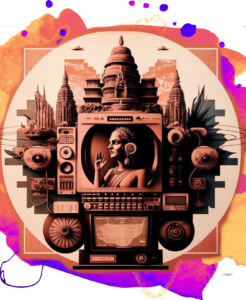Aim at the eye of cinema!!!
Harichara chi factory is a 2009 Indian Marathi-language biographical film written and directed by Paresh Mokashi. It is about Dadasaheb Phalke, who made the first Indian feature film Raja Harishchandra (1913) and starring Nandu Madhav as him and Vibhavari Deshpande as his wife Saraswati. Harishchandrachi Factory focuses on the struggle Phalke faced during its production.
I found Dharma as the most dominant element in the cinema. When we look at this film from the lens of Dharma, we can get the real crux of it. Before jumping into the lens let’s try to understand the nature of our lens.
Dharma – What does it stand for?
Dharma is not something mere religion. ‘Dharayati Iti Dharma’ – That which supports, maintains, nourishes, harmonizes, brings together, and unites the inert and the sentient, the individual and the society, nation, and the world is dharma. In another sense, one can even perceive it as the highest form of duty (Kartavya) that has to be followed. Before taking it on higher scales of universal alignment, let’s speak of that specific Tatva which worked very efficiently for Dada Saheb Phalke. And it is known as Swa -Dharma. In every stage of life, Dadasaheb Phalke firmly believed in his vision. The clear vision of a person will always lead him down the path of clarity. It is that clarity that upholds the performance of Dharma. Reinfocrces the swayam (self) in every step ahead.
What did Plahake Ji see in cinema which others couldn’t?
When Phalke observed cinema, it was not more than a motion picture, narrating a form of the story in earlier days. “The Life of Christ” might’ve been seen by many others before him. But, what motive he had while looking at the film was way different than others’ ideas. He connected in deep with the storyline and thought why can’t Indigenous stories be told through this medium? Even during the vulnerable economic condition of his family, he arranges, convinces his family, and flies to London in 1912.
There he learns the craft from British pioneer filmmaker Cecil Hepworth. After returning to Bharat he tries to make his first-ever silent film Raja Harischadra, during which he faces several difficulties in execution. But in 1913 he brings his dream onto screens. Later when his work was celebrated throughout the world and gets an opportunity in London to work with them. Still, he refuses gently and says that I’ve to work and create a base for films in Bharat.
It’s clear evidence of his love for the motherland and passion for his work. In all the above major events of his life, he has adhered to his Swa- Dharma. Motivation to bring our stories from Purana and Itihasa was alone his goal. And this goal which was deeply rooted in his Swa Dharma helped him to achieve success as well as become a driving force in all challenging situations. Indirectly, the story depicts the character of a man whose life itself is a journey of construction, protection, consistent action toward his Swadharma. That’s when he was able to aim at the eye of cinema.
The journey of “Harishchandrachi Factory” to the Oscars
The journey of “Harishchandrachi Factory” to the Oscars underscored the growing recognition of Indian cinema on the global stage and the importance of preserving and celebrating its history and heritage. It remains a significant film in the history of Indian cinema and a testament to the enduring legacy of Dadasaheb Phalke.
Blends a vintage feel with a realistic aesthetic
“Harishchandrachi Factory” exudes a vintage charm with its meticulous attention to detail and a realistic aesthetic touch. The film transports viewers to the early 20th century, capturing the essence of that era with its authentic costumes, period settings, and vintage cinematography. The attention to historical accuracy and the use of sepia tones create a nostalgic atmosphere. This commitment to recreating the past enhances the film’s storytelling, providing a genuine and immersive experience. “Harishchandrachi Factory” is a cinematic masterpiece that seamlessly blends a vintage feel with a realistic aesthetic, making it a memorable tribute to the birth of Indian cinema.


